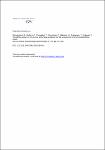The MRSA-import in ICUs is an important predictor for the occurrence of nosocomial MRSA cases
Schweickert, Birgitta
Geffers, Christine
Farragher, T.
Gastmeier, Petra
Behnke, Michael
Eckmanns, Tim
Schwab, F.
Nosocomial infections with methicillin-resistant Staphylococcus aureus (MRSA) account for increased morbidity, mortality and healthcare costs in critically ill patients worldwide. The intensive care unit (ICU) component of the German surveillance system for nosocomial infections (Krankenhaus-Infektions-Surveillance-System, KISS) has been supplemented with a module targeting the surveillance of multiresistant pathogens [Multiresistente Erreger (MRE)-KISS] in order to account for the increasing burden of antibiotic-resistant bacteria. The aim of this study was to assess the association between structural and organizational characteristics of ICUs and the number of nosocomial MRSA cases. Data were derived from routine data collected in the frame of the national surveillance system of nosocomial infections (ICU- and MRE-KISS) from January 2007 to December 2008 and from a questionnaire inquiring about structure and process parameters. One hundred and forty ICUs performing active screening have been included. Process parameters such as isolation of MRSA patients, decolonization procedures and introduction of MRSA alert systems have been implemented by the majority of the ICUs, whereas the application mode of screening procedures and pre-emptive isolation measures is heterogeneous. Multivariable analysis using negative binominal regression models shows that a stay on a medical ICU has a protective effect (incidence rate ratio, 0.42; 95% confidence interval, 0.24–0.74; p = 0.003), whereas the imported MRSA incidence is significantly associated with the number of nosocomial MRSA cases (incidence rate ratio, 1.74; 95% confidence interval, 1.23–2.45; p = 0.002). Structure and process parameters do not show any effect. ICU type and imported MRSA incidence should be considered for benchmarking between hospitals.
Dateien zu dieser Publikation
Keine Lizenzangabe

